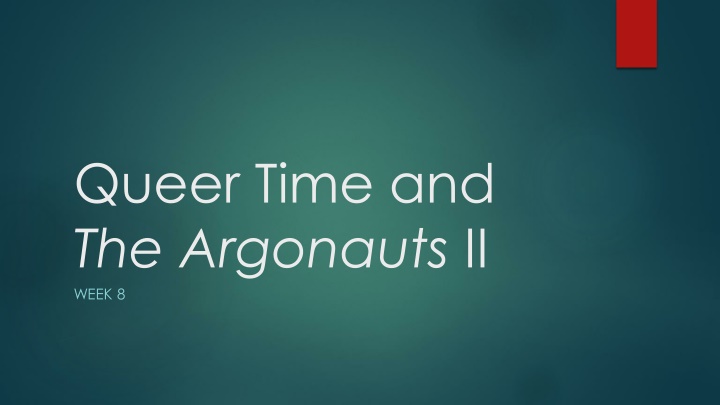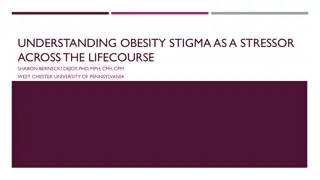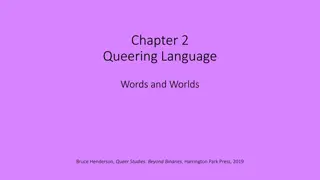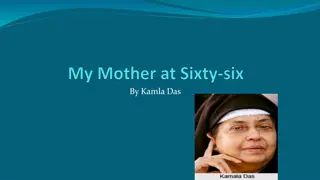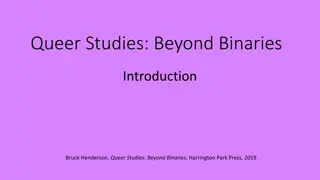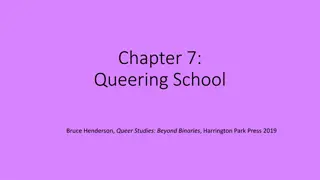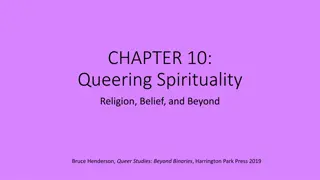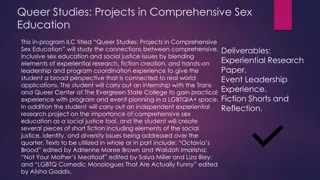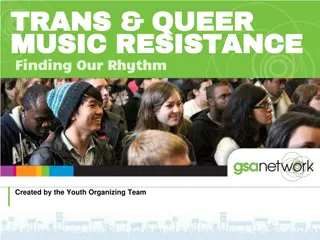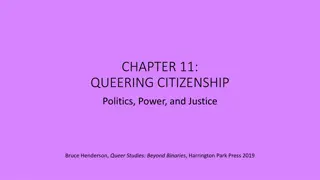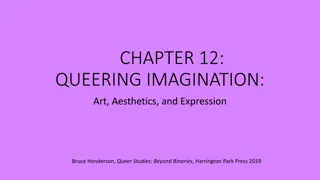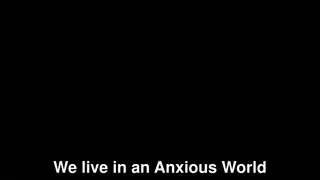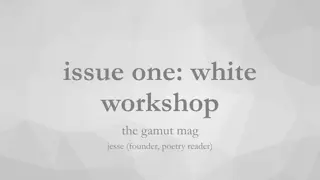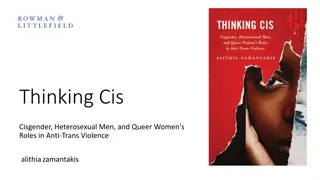Queer Time and The Argonauts II: Juxtaposed Elements of Lifecourse
The content delves into the interactions of apparently heteronormative and queer elements, exploring how they relate to lifecourse. It showcases moments from "The Argonauts" by Maggie Nelson and Olivia Laing, reflecting on adult and childlike aspects within diverse contexts.
Download Presentation

Please find below an Image/Link to download the presentation.
The content on the website is provided AS IS for your information and personal use only. It may not be sold, licensed, or shared on other websites without obtaining consent from the author.If you encounter any issues during the download, it is possible that the publisher has removed the file from their server.
You are allowed to download the files provided on this website for personal or commercial use, subject to the condition that they are used lawfully. All files are the property of their respective owners.
The content on the website is provided AS IS for your information and personal use only. It may not be sold, licensed, or shared on other websites without obtaining consent from the author.
E N D
Presentation Transcript
Queer Time and The Argonauts II WEEK 8
Maggie Nelson and Olivia Laing: The Argonauts Maggie Nelson and Olivia Laing: The Argonauts - YouTube
Tina Jane Lupton, Queer Times for the Straight Book, Post-45 (2019), vol. 3, n. p. Iggy is gestating and has been born, a love is being worked out and has already arrived, and a gender transition is happening even as Harry is "not going anywhere. [ ] The Argonauts is written without a clear narrative trajectory. Of course, the essay form has long supported baggy timelines and reverse chronologies Harry's transition (he has top surgery and starts taking testosterone during the years related in The Argonauts) and Nelson's pregnancy are both presented in this vein as provocations to think differently of the lifetime. Here, for instance, Nelson describes eating with Harry just after his surgery in the restaurant of their hotel: You pass as a guy; I, as pregnant. Our waiter cheerfully tells us about his family, expresses delight in ours. On the surface, it may have seemed as though your body was becoming more and more "male," mine more and more "female." But that's not how it felt on the inside. On the inside, we were two humans undergoing transformations beside each other bearing loose witness. In other words, we were aging.
One of the few evenings beyond the house that [Nelson] describes in The Argonauts ends when she and Harry are denied entrance to a friend's trapeze- burlesque show because they have their baby with them. Another outing, to an art porn movie, happens in response to Harry's sense of isolation in LA. When they are questioned about Harry's identity, it's while shopping for their Thanksgiving pumpkin. Living in a city traversed by highways and portioned out into residential plots, Nelson and Harry come across as securely moored to their red sofa, most occupied, in their lines of communication, with each other and their mothers. (Lupton, 5) Interaction of the (apparently heteronormative) and the queer: locales, customs, gendered activities, transgressive and normative. How do such juxtaposed elements relate to lifecourse? What is adult here (in any sense and what senses are you invoking)? What might be seen to be childlike?
[Harry] at a certain point I woke up. I listened for her breath, which I heard after a moment. much shallower, faster. I became alert, just then the AC unit went on, aurally overtaking the sound of her. this had happened innumerable times before, and it was always a strange bardo for me. would the breath still be happening when the fan went off? I strained to hear her breath over the grinding of the fan but couldn t. my torso leapt and I sat up to check if her chest was moving. it didn t seem to be. the AC roared. her left hand puffed the sheet up suddenly, the tiniest, instant halloween ghost. her first movement a signaling. I leapt to her, to that hand. her eyes were open now, illuminated, looking up, her mouth was now closed, her face no longer tilted, akimbo. she was beautiful and dying. her mouth was in slow motion rounding up little bits of earth air for her lungs, or just an echo of that I guess. her eyes were in light and open. she was jutting her chin in the sweetest, most dignified little coquettish juts. she was in the doorway of all worlds and I was in the doorway too. I forced myself not to disturb her, she seemed all at once to know where she was going and how to get there. her map. her job. the goal at hand. I cupped her warm hand in mine and let her go. I told her one more time, you are surrounded in love, you are surrounded in light, don t be afraid, and her neck was pulsing a little bit? her eyes were looking at something in another place. her mouth needed less air, less often, and her chin moving more slowly. I never wanted it to end. I have never wanted infinity to open up under an instant like I wanted that then. and then her eyes relaxed and her shoulders relaxed of a piece, and I knew she had found her way. dared. summoned up her smarts and courage and whacked a way through. I was really astonished. proud of her. I looked at the clock. it was 2:16. (163-64)
Lifewriting, (textual) genesis and genre The Argonauts is written without a clear narrative trajectory. [ ] Of course, the essay form has long supported baggy timelines and reverse chronologies (Lupton, 3) [Y]ou can't write and hold a baby (or read [or write] while attending a party, making love, building a house, teaching, or doing most kinds of political work) [this] also sets the tone for The Argonauts broader biographical structure. For while Nelson refuses the before and after of life and death; the telos of courtship, reproduction, and gender transition, she draws very strongly on the logic of reading as something that comes before writing and on texts as things that must be written before they can be read. Her life as a graduate student forms, in this sense, the necessary prelude to The Argonauts because it was then that she did the reading that underpins the writing she is doing now. (Lupton, 6) The reservoir of virtual conversation upon which she now draws is not even physically present as a library: Nelson tells us that she writes away from her books, in coffee shops where the hours in which she might look up references are limited by the costs of childcare. (Lupton, 6)
Monica Pearl, Theory and the Everyday, Angelaki, 200 Nearly all commentary on The Argonauts refers to its genre bending, for example: Genres in this book are bent beyond recognition; boundaries are transcended and ignored (Szalai) and: While many critics call this book a memoir, I see it as more of a genre-bender (Hagan 39). The term genre bending is a not very oblique reference to the still fairly recent, yet nevertheless now practically dated, concept of gender bending, and some commentary refers more directly to the text as gender bending: this gender-bending memoir (de Le n). Genre and gender are the same word, a kind or type, and come from the same root (the root gen means to give birth, beget). And: Neither genre nor gender is as categorically stable as common usage tends to imply (Stevens). The book is a paradox not only of content but also of genre. The title, The Argonauts, in referring to a structure a ship is also referring to a genre. In other words, genre works in precisely this way: it has a rough structure and with it a name. Those things that fit into the rubric of that structure are called by that name; at the same time, what is claimed and named under that structure changes the category. Maggie Nelson calls The Argonauts autotheory, a combination of autobiography and critical theory. But by using critical theory in her autobiographical account she is stretching the category of autobiography (and possibly also of critical theory). [ ] Nelson conjures Eve Sedgwick s concept of queer as a kind of placeholder a nominative, like Argo, willing to designate molten or shifting parts (29). At the same time, naming a category transforms the contents. Of pictures in an exhibition, Nelson observes that Some of the subjects of Puppies and Babies may not identify as queer, but it doesn t matter: the installation queers them (72). (Pearl, 200-201)
Most recently in her autobiographical narratives and performance pieces, Sedgwick has revealed her personal transgendered investment lying at and as the great heart of her queer project. Her confession of her identification? Dare I, aft er this half-decade, call it with all a fat woman s defi ance, my identity? as a gay man comes out with the transgendered desire that has been present in her work (Jay Prosser, 258- 259) Annoying as it may be to hear a straight white guy talk about a book of his as queer in the end it s probably all for the better. Sedgwick, who was long married to a man with whom she had, by her own description, mostly post-shower, vanilla sex, knew about the possibilities of this first- person use of the term [queer] perhaps better than anyone else. She took heat for it, just as she took heat for identifying with gay men (not to mention as a gay man), and for giving lesbians not much more than an occasional nod. (The Argonauts, 36)
Pearl, 202 We might be able to queer marriage and queer the couple and motherhood and the body, but can we queer feelings? It may be disappointing to conclude that there is no queer love there is only that ordinary love that everyone feels and everyone expresses with the same words. It may be that we feel it differently, more deeply, more magnificently than anyone ever has felt it before, but literature (for example) tells us otherwise. That whatever intoxication we experience is just that. (Freud likens being in love to hypnosis a kind of rudderless ensorcelled submission (Freud 144 45).) Perhaps this is what The Argonauts is doing, besides exciting us with its innovative amalgam of genres and gender, something more quotidian than queer. Which anyway is what Maggie Nelson has been telling us all along, that whatever we think we are innovating or learning, we are probably telling ourselves something we already knew, again: Sometimes one has to know something many times over. Sometimes one forgets, and then remembers. And then forgets, and then remembers. And then forgets again (18).
Lupton, 8 Kathryn Bond Stockton (to a queer audience of readers): Sure you read Bataille, teach Bersani, and luxuriate in Lee Edelman. But I think, like me, you're likely to be uber- Protestant-work-ethic-hounds at your labors six days a week with one day one blessed day for queer hedonism lived to the hilt. (Stockton, 345; cited in Lupton, 8)
Works Cited Tina Jane Lupton, Queer Times for the Straight Book , Post- 45 (2019), vol. 3, n. p. Monica Pearl, Theory and the Everyday , Angelaki, vol. 23, no. 1 (2018), 199-203 Kathryn Bond Stockton, "Rhythm: Secular Feelings, Religious Feelings" in Queer Times, Queer Becomings, eds.E. L. McCallum and Mikko Tuhkanan (Albany: SUNY Press, 2011)
Reading journal/ portfolio 6-8 entries Totalling 3500 words for intermediate years; 4500 for finalists (divided up as you wish) You can use what you wrote in your formative if you haven t already. Short discussions of how what you have read (or watched or seen) books, films, visual art, other cultural media off the module (in your cultural life, on other modules) might be read in relation to the ideas and theories on the module. These can also be your own further reflections on things that we have read You don t need to be quite as rigorous with referencing as an essay but do give a Works Cited list at the end (or in a separate PDF) of anything that you mention. In years past people have made beautiful illustrated commonplace books of these journals obviously I can t take these in this year and this is just for your own pleasure, but do feel free to do this?! (Do make sure you upload an electronic version to Tabula as your submission though!)
